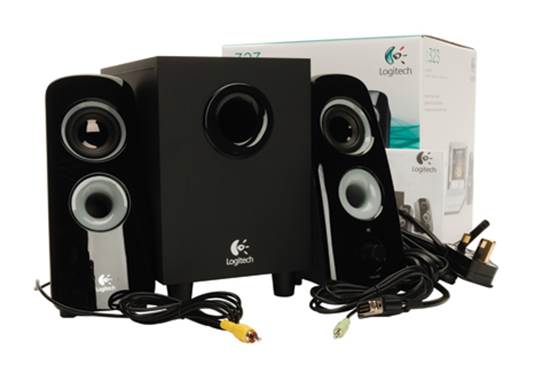Logitech has built more computer speakers
over the years than just about any manufacturer, and it’s learned a thing or
two about building decent low-cost models. Take the 2.1-channel Z323 system: We
could name any number of speaker systems that sound better, but few that are
priced better.

Logitech
Z323 2.1 Channel Speaker System
You can literally see some of the ways that
Logitech hit that low price point: The satellite cabinets are made from cheap
ABS plastic with permanently attached cables that plug into the subwoofer. Each
satellite has dual, 2-inch, concave-dome drivers (one is mounted in the front
of the cabinet and the other in the back, to deliver what Logitech describes as
"360-degree sound"). So the system performs best if there’s a wall
behind the satellites for the sound waves to bounce off. Each satellite also
has a front-facing port. There’s a volume control and power switch on the
right-hand cabinet, plus one 1/8-inch headphone output and one 1/8-inch stereo
input, to support a digital media player.
The compact subwoofer cabinet (it measures
8.7x5.9x7.2 inches) is fabricated from the typical medium-density fiberboard.
It houses a small amp and a tiny (for a sub) 4-inch down-firing dome woofer.
The amp delivers six watts (RMS) to each of the satellites and 18 watts (RMS)
to the subwoofer. The sub has its own volume control, along with a pair of RCA
jacks that serve as a second auxiliary input for a gaming console, DVD player,
or what have you (handy features in a speaker system priced this low).

The
satellites tilt up to project sound at your ears
The Z323's favorable price/performance ratio,
however, applies to games much more than music. Playing games such as
Borderlands 2, we were pleased with the Z323’s ability to render the sound of
gunshots and explosions, and the conversations with friendly characters and the
taunts of enemies alike were rendered crisp and clear (well, with the exception
of those babbling psychos).
When we listened to music, on the other
hand, the vocals sounded weirdly detached from the rest of the band and it
didn't matter whether the singer was male or female or even what style of music
was being played. We tried several singer/songwriters, including "Crossing
Muddy Waters,” from the John Hiatt album of the same name. Marc Cohn’s
"She’s Becoming Gold," from The Rainy Season, and Nanci Griffith’s
cover of Townes Van Zandt’s "Techumseh Valley," from her record Other
Voices, Other Rooms (in all three cases, the tracks were ripped from CD and
encoded as 16-bit, 44.1kHz FLAC files).

Logitech
Z323 2.1 Channel Speaker - details
This sonic detachment wasn’t as much of a
problem with instrumental selections, but that’s not to say the Z323 system
delivered a stellar performance. When we played Mike Oldfield’s Tubular Bells,
which the composer recently re-mastered for Bowers & Wilkins’s Society of
Sound label, the album (available in both Apple Lossless and 24-bit FLAC
formats), sounded somewhat lifeless and flat compared to what we heard on more
expensive speakers (including Corsair’s stellar SP2500 system). But you could
almost buy four Z323 setups for the cost of one SP2500, so that’s to be
expected.

If
listening to music is your core interest, on the other hand, you should keep
looking.
If you’re working with a tight budget and
need speakers primarily for gaming, Logitech has a good set in the Z323. If
listening to music is your core interest, on the other hand, you should keep
looking.
|
Specifications
§ Product
Description: Logitech Z323 Speaker System/2.1 set
§ Product
Type: Speaker System
§ Performance:
30 watts (RMS)
§ Frequency
response: 40 Hz – 20 kHz
§ System
Requirements - Windows based: Windows® XP or Windows Vista®, Sound card or
3.5 mm audio out .
§ System
Requirements - Mac® computer: Mac OS® X 10.3.9 or later, Sound card or 3.5 mm
audio out
§ Satellites:
2 x 6 watts (RMS) (into 4 ohms, @1kHz, @10% THD), Integrated volume control,
Dual drivers for omnidirectional acoustics
§ Subwoofer:
18 watts (RMS) (into 6 ohms, @100Hz, @10% THD), Integrated bass control
§ Connections:
Inputs - Stereo RCA, 3.5 mm primary input, 3.5 mm auxiliary input, Outputs -
3.5mm headphone jack
§ Drivers:
5.1 cm concave dome driver, 10.2 cm down-firing dome driver
§ Speaker
dimensions (H x W x D): Satellites: - 20.3 cm x 8.7 cm x 13.5 cm, Subwoofer:
- 22.1 cm x 15 cm x 18.2 cm
§ Warranty:
2-year manufacturer's guarantee
|